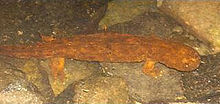| Cryptobranchoidea | |
|---|---|

| |
| Cryptobranchus alleganiensis | |

| |
| Hynobius fossigenus | |
| Scientific classification | |
| Domain: | Eukaryota |
| Kingdom: | Animalia |
| Phylum: | Chordata |
| Class: | Amphibia |
| Order: | Urodela |
| Suborder: | Cryptobranchoidea Dunn, 1922 |
| Subgroups | |
| |
The Cryptobranchoidea are a suborder of salamanders found in Asia, European Russia, and the United States. They are known as primitive salamanders, in contrast to Salamandroidea, the advanced salamanders.[1] It has two living subdivisions, Cryptobranchidae (Asian giant salamanders and hellbenders), and Hynobiidae, commonly known as Asian salamanders.
Giant salamanders are obligate paedomorphs with partial metamorphosis,[2] but Asiatic salamander goes through a full metamorphosis. The only known exceptions are the Longdong stream salamander, which has been documented as facultatively neotenic, and the Ezo salamander, where a now assumed extinct population from Lake Kuttarush in Hokkaido had neotenic traits like gills in adults.[3]
The oldest members of the group are known from the Middle Jurassic (Bathonian) aged Yanliao Biota of China.[4]
- ^ Heying, Heather. "ADW:Family Cryptobranchidae: giant salamanders and hellbenders".
- ^ Bonett, Ronald M.; Blair, Andrea L. (2017). "Evidence for complex life cycle constraints on salamander body form diversification". Proceedings of the National Academy of Sciences. 114 (37): 9936–9941. Bibcode:2017PNAS..114.9936B. doi:10.1073/pnas.1703877114. PMC 5604006.
- ^ Jiang, J. P.; Jia, J.; Zhang, M.; Gao, K. Q. (2018). "Osteology of Batrachuperus londongensis (Urodela, Hynobiidae): Study of bony anatomy of a facultatively neotenic salamander from Mount Emei, Sichuan Province, China". PeerJ. 6: e4517. doi:10.7717/peerj.4517. PMC 5878659. PMID 29610705.
- ^ Jia, Jia; Anderson, Jason S.; Gao, Ke-Qin (2021-07-23). "Middle Jurassic stem hynobiids from China shed light on the evolution of basal salamanders". iScience. 24 (7): 102744. Bibcode:2021iSci...24j2744J. doi:10.1016/j.isci.2021.102744. ISSN 2589-0042. PMC 8264161. PMID 34278256.